Shear Strength Analysis of Anti-Rust Bolts with a Spiral Oil-Guiding Slot and Oil-Bearing Hole: Simulation and Experiment
Abstract
:1. Introduction
2. Finite Element Analysis
2.1. Finite Element Modeling
2.2. Boundary Conditions of the Finite Element Model
2.3. Progressive Failure Analysis and Material Properties of the Bolt
2.4. Results of the Analysis
3. Shear Experiment of the Bolt
4. Substitute Calculation
5. Conclusions
- The indirect method can be used to obtain spiral entities that can exhibit excellent spiral elements: First, spiral leading lines and baselines are generated; then, spiral surfaces are formed by two spiral leading lines and baselines. Finally, the spiral entity is generated by two corresponding spiral curved surfaces.
- When the merging nodes method is used, the force transfer between the nodes is more concentrated; when the gluing contact method is used, the nodes in the corresponding area are needed for transferring forces. The stress exhibited the maximum value in the area within a distance of 12.2 mm from both ends of the bolt. The bolt is sheared on both sides, and the side with the oil-bearing hole is sheared first. The simulation’s results are in good agreement with the experimental results, showing the effectiveness of the bolt’s model in progressive failure analyses.
- The deviation between the result obtained by using the substitute calculation and the experimental result is small (7.97%).
Author Contributions
Funding
Data Availability Statement
Conflicts of Interest
References
- Lev, B.; Bortnik, L. Anti-Rust Coating. WO2002060999A1, 8 August 2002. [Google Scholar]
- Wang, J. Antirust Bolt Cover. CN201120434031X, 12 September 2012. [Google Scholar]
- Weeder, S.; Vavruch, P. Improving anti-rust property of EP industrial gear oil. Ind. Lubr. Tribol. 2002, 54, 219–224. [Google Scholar] [CrossRef]
- Cho, J.R.; Lee, D.Y.; Yoo, W.S.; Lim, O.K. Numerical investigation of bolt fitting and fastening forces by elastoplastic finite element analysis. Int. J. Adv. Manuf. Technol. 2013, 66, 71–81. [Google Scholar] [CrossRef]
- Liu, X.; Bradford, M.A.; Chen, Q.J.; Ban, H. Finite element modelling of steel-concrete composite beams with high-strength friction-grip bolt shear connectors. Finite Elem. Anal. Des. 2016, 108, 54–65. [Google Scholar] [CrossRef]
- Pilone, D.; Brotzu, A.; Felli, F. Failure analysis of connecting bolts used for anchoring streetlights of a mountain highway. Eng. Fail. Anal. 2015, 48, 137–143. [Google Scholar] [CrossRef]
- Du, A.; Liu, Y.; Xin, H.; Zuo, Y. Progressive damage analysis of PFRP double-lap bolted joints using explicit finite element method. Compos. Struct. 2016, 152, 860–869. [Google Scholar] [CrossRef]
- Coelho, A.M.G.; Mottram, J.T. A review of the behaviour and analysis of bolted connections and joints in pultruded fibre reinforced polymers. Mater. Des. 2015, 74, 86–107. [Google Scholar] [CrossRef]
- Lee, Y.G.; Choi, E.; Yoon, S.J. Effect of geometric parameters on the mechanical behavior of PFRP single bolted connection. Compos. Part B Eng. 2015, 75, 1–10. [Google Scholar] [CrossRef]
- Gantes, C.J.; Lemonis, M.E. Influence of equivalent bolt length in finite element modeling of T-stub steel connections. Comput. Struct. 2003, 81, 595–604. [Google Scholar] [CrossRef]
- Liu, X.; Bradford, M.A.; Lee, M.S.S. Behavior of High-Strength Friction-Grip Bolted Shear Connectors in Sustainable Composite Beams. J. Struct. Eng. 2015, 141, 04014149. [Google Scholar] [CrossRef]
- Liu, P.; Cheng, X.; Wang, S.; Liu, S.; Cheng, Y. Numerical analysis of bearing failure in countersunk composite joints using 3D explicit simulation method. Compos. Struct. 2016, 138, 30–39. [Google Scholar] [CrossRef]
- Ataei, A.; Bradford, M.A.; Valipour, H.R.; Liu, X. Experimental study of sustainable high strength steel flush end plate beam-to-column composite joints with deconstructable bolted shear connectors. Eng. Struct. 2016, 123, 124–140. [Google Scholar] [CrossRef]
- Ataei, A.; Bradford, M.A.; Valipour, H.R. Experimental study of flush end plate beam-to-CFST column composite joints with deconstructable bolted shear connectors. Eng. Struct. 2015, 99, 616–630. [Google Scholar] [CrossRef]
- Ataei, A.; Bradford, M.A.; Liu, X. Experimental Study of Flush End Plate Beam-to-Column Composite Joints with Precast Slabs and Deconstructable Bolted Shear Connectors. Structures 2016, 7, 43–58. [Google Scholar] [CrossRef]
- Ataei, A.; Bradford, M.A.; Liu, X. Experimental study of composite beams having a precast geopolymer concrete slab and deconstructable bolted shear connectors. Eng. Struct. 2016, 114, 1–13. [Google Scholar] [CrossRef]
- Egan, B.; Mccarthy, C.T.; Mccarthy, M.A.; Gray, P.J.; Frizzell, R.M. Modelling a single-bolt countersunk composite joint using implicit and explicit finite element analysis. Comput. Mater. Sci. 2012, 64, 203–208. [Google Scholar] [CrossRef]
- Xin, A.; Zhao, L.B. Failure Analysis of Single-Lap Single-Bolt Composite Joints with Countersunk Fasteners. Appl. Mech. Mater. 2014, 620, 425–428. [Google Scholar] [CrossRef]
- Turvey, G.J.; Wang, P. An FE Analysis of the Stresses in Pultruded GRP Single-Bolt Tension Joints and Their Implications for Joint Design. Comput. Struct. 2008, 86, 1014–1021. [Google Scholar] [CrossRef]
- Atas, A.; Soutis, C. Strength prediction of bolted joints in CFRP composite laminates using cohesive zone elements. Compos. Part B Eng. 2014, 58, 25–34. [Google Scholar] [CrossRef]
- Persson, K.; Froling, M. Designing Bolt-Fixed Laminated Glass with Stress Concentration Factors. Struct. Eng. Int. 2013, 23, 55–60. [Google Scholar]
- Juoksukangas, J.; Lehtovaara, A.; Mantyla, A. Experimental and numerical investigation of fretting fatigue behavior in bolted joints. Tribol. Int. 2016, 103, 440–448. [Google Scholar] [CrossRef]
- Lyu, Y.F.; Li, G.Q.; Wang, Y.B.; Li, H.; Wang, Y.Z. Bearing behavior of multi-bolt high strength steel connections. Eng. Struct. 2020, 212, 110510. [Google Scholar] [CrossRef]
- Belardi, V.G.; Fanelli, P.; Vivio, F. Analysis of multi-bolt composite joints with a user-defined finite element for the evaluation of load distribution and secondary bending. Compos. Part B Eng. 2021, 227, 109378. [Google Scholar] [CrossRef]
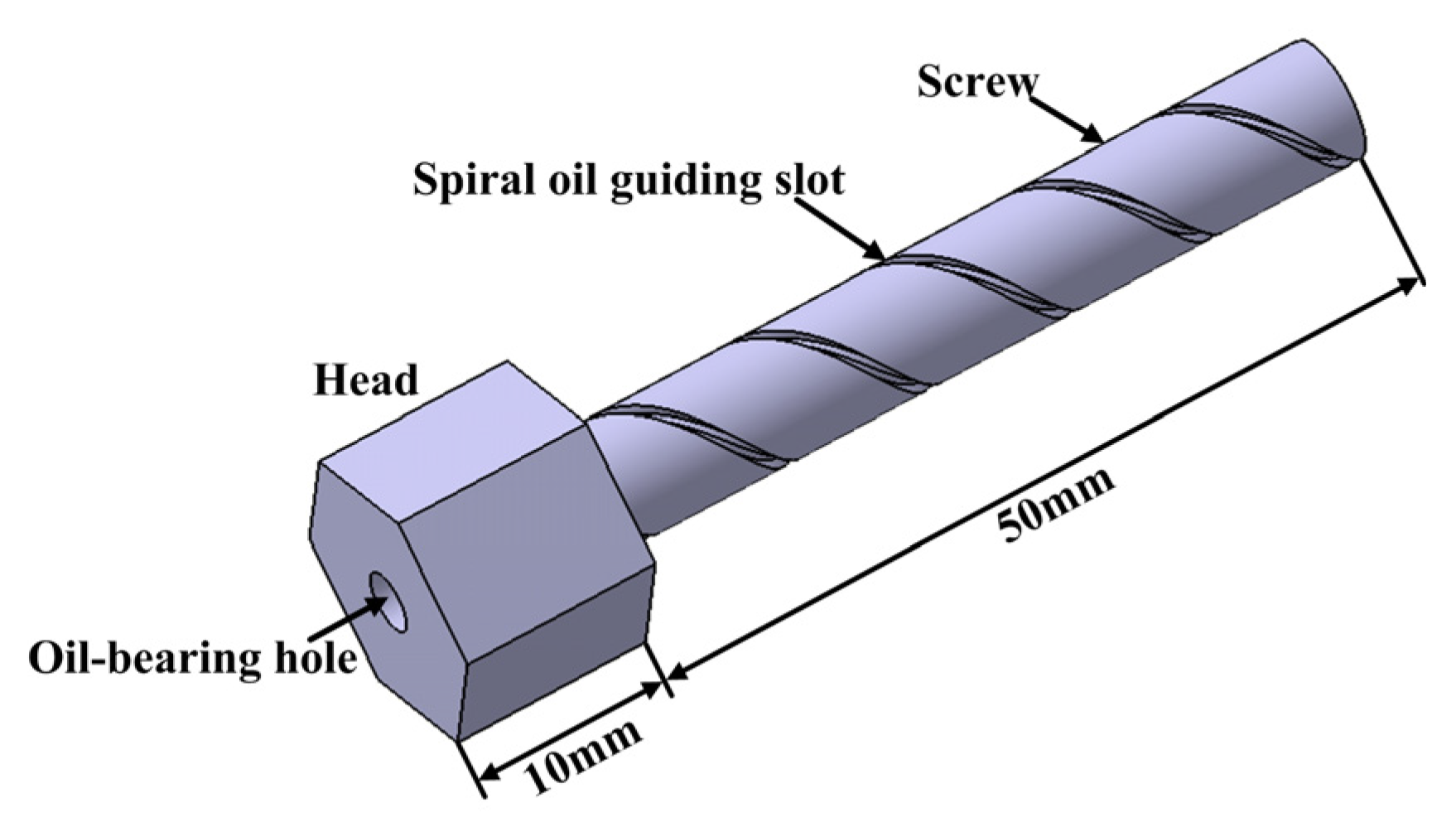
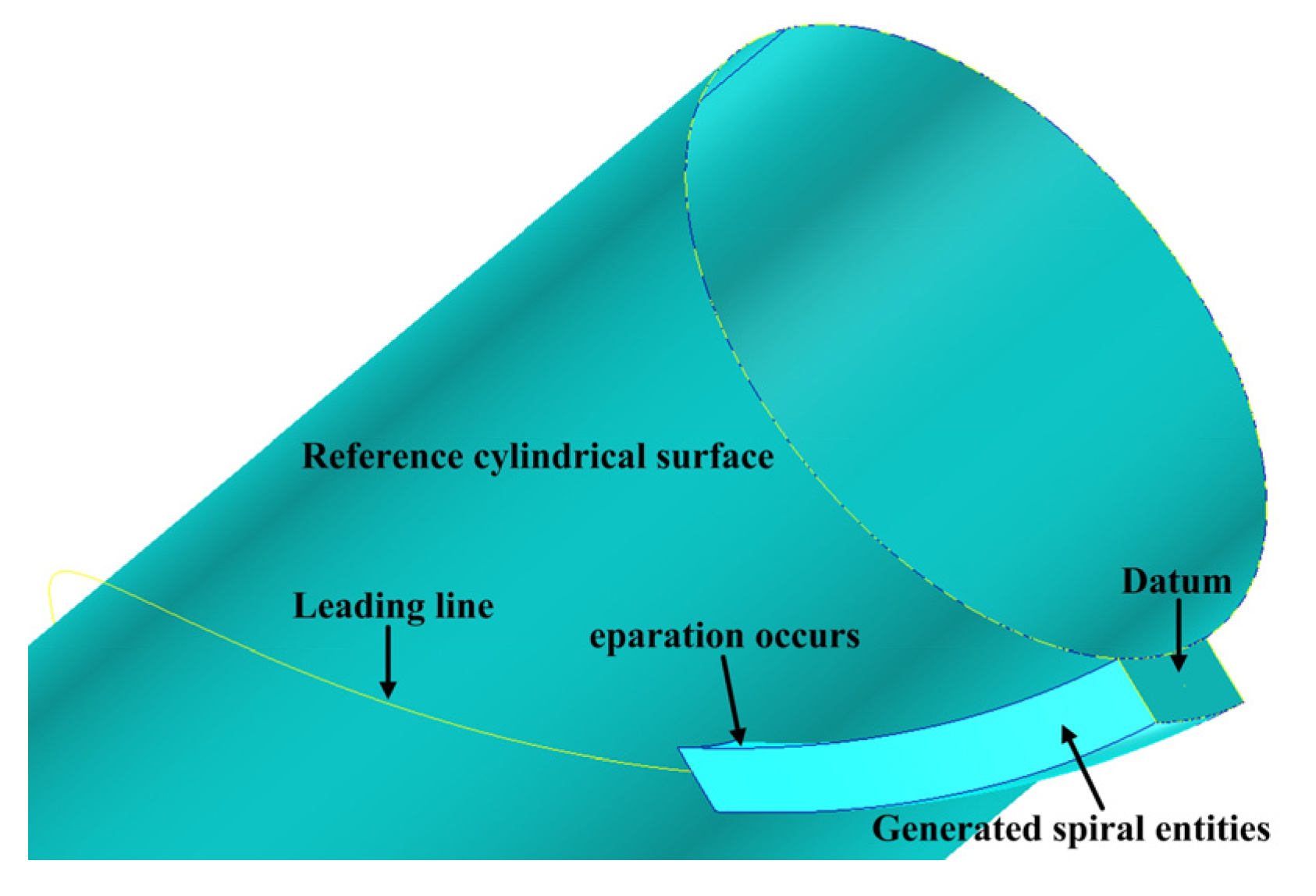
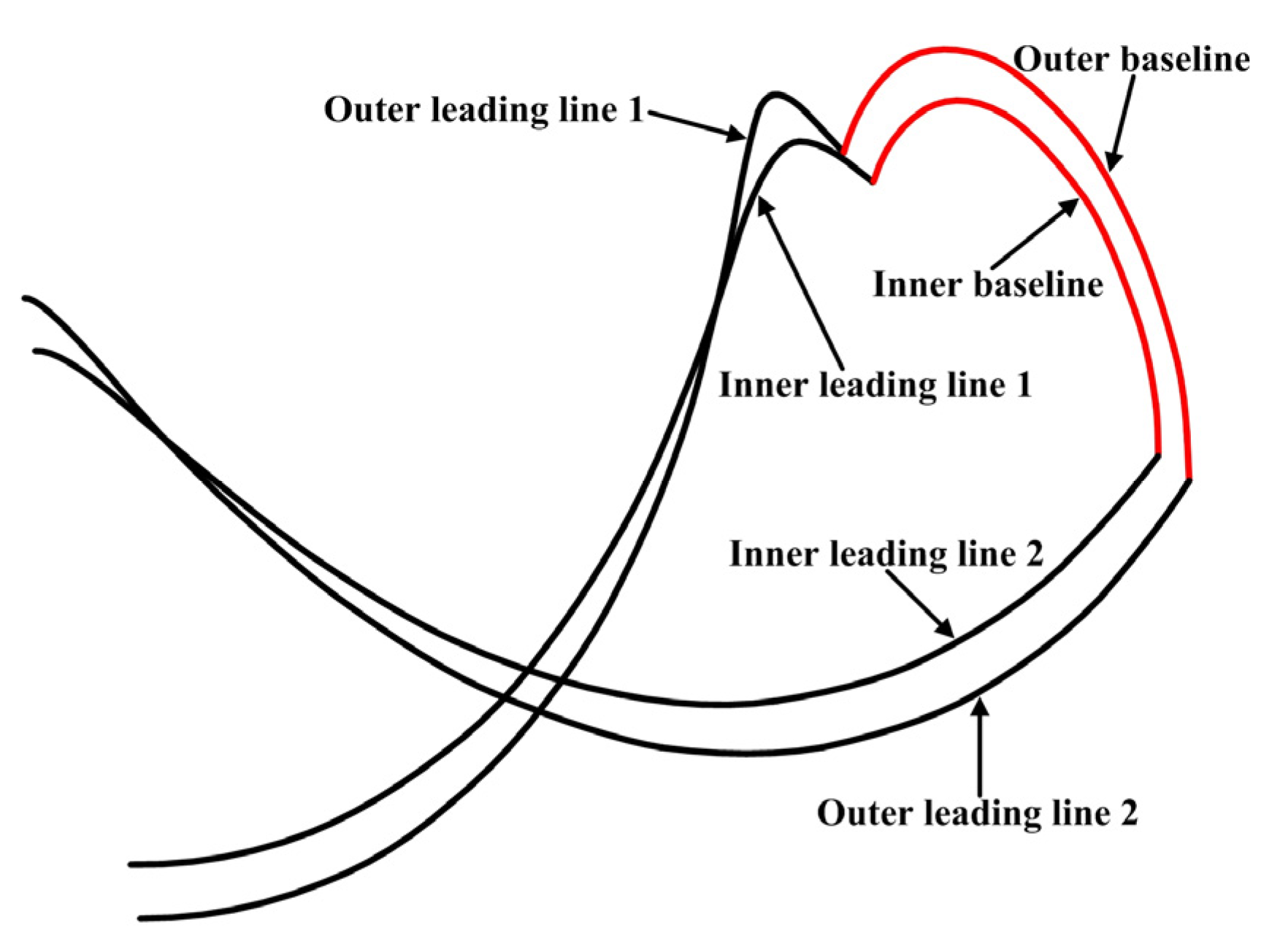

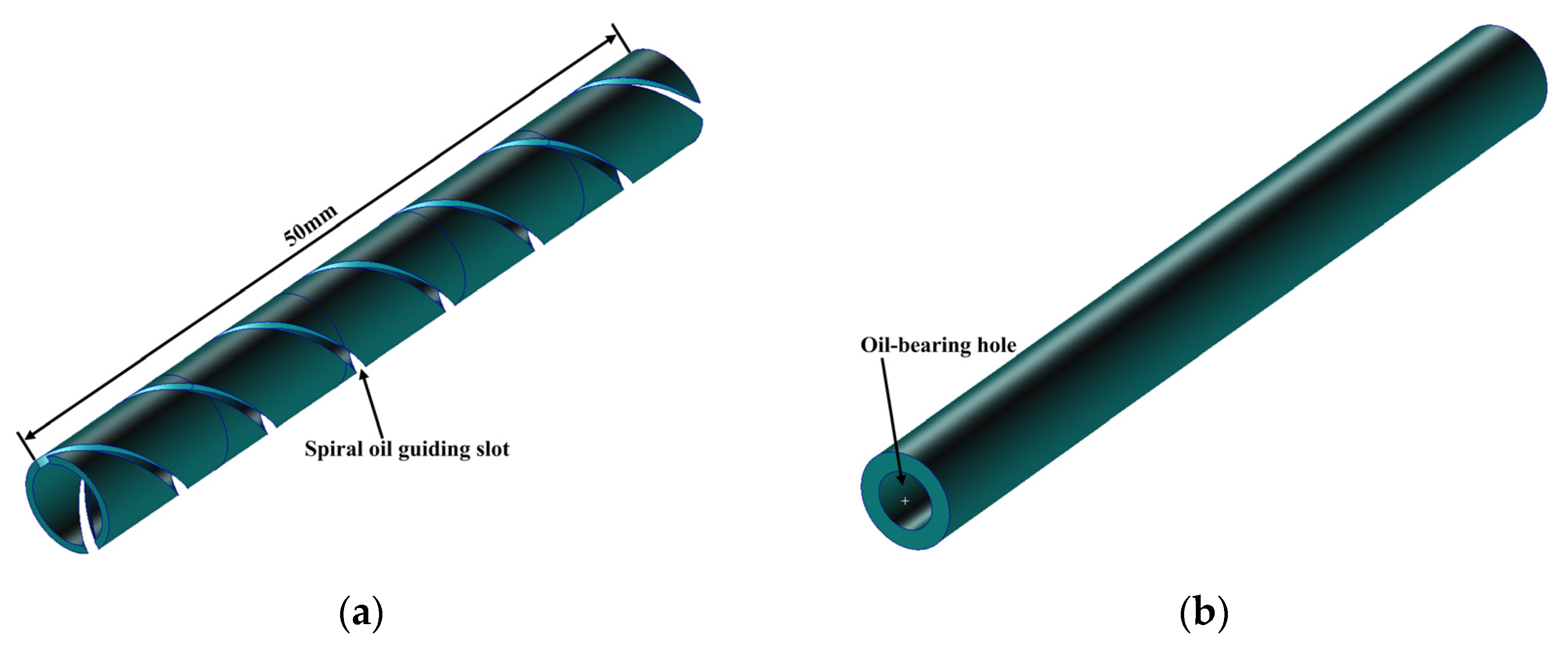
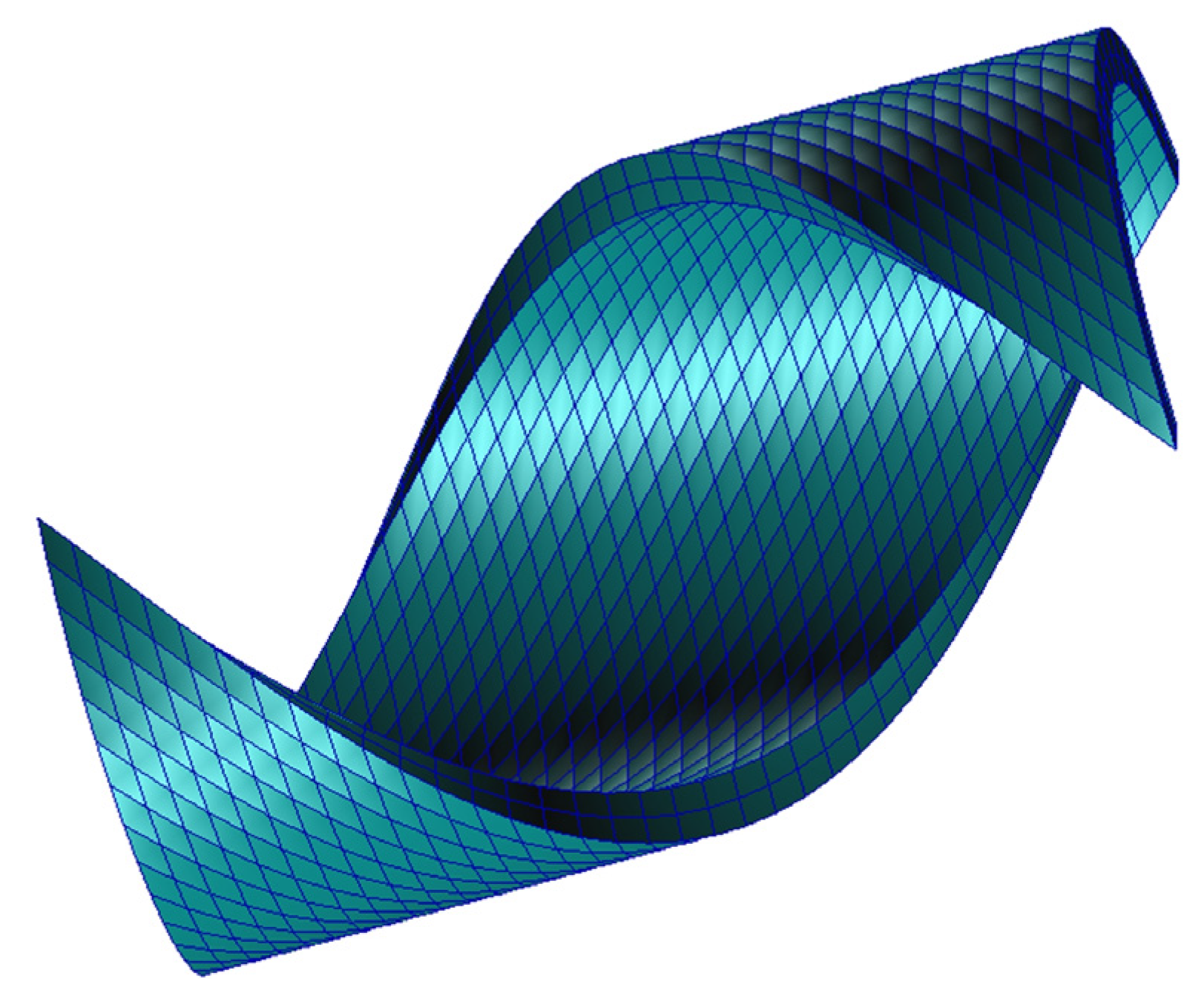
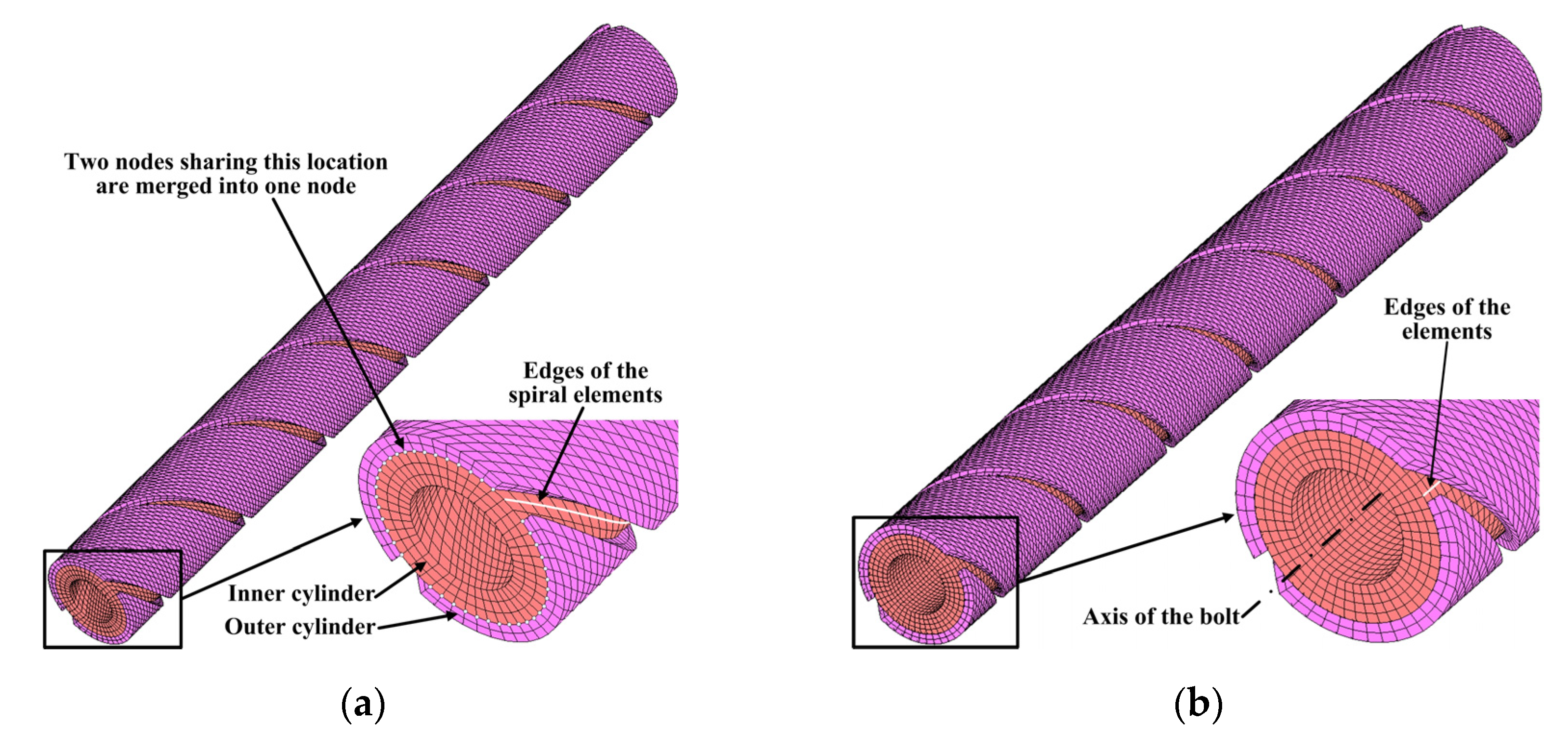
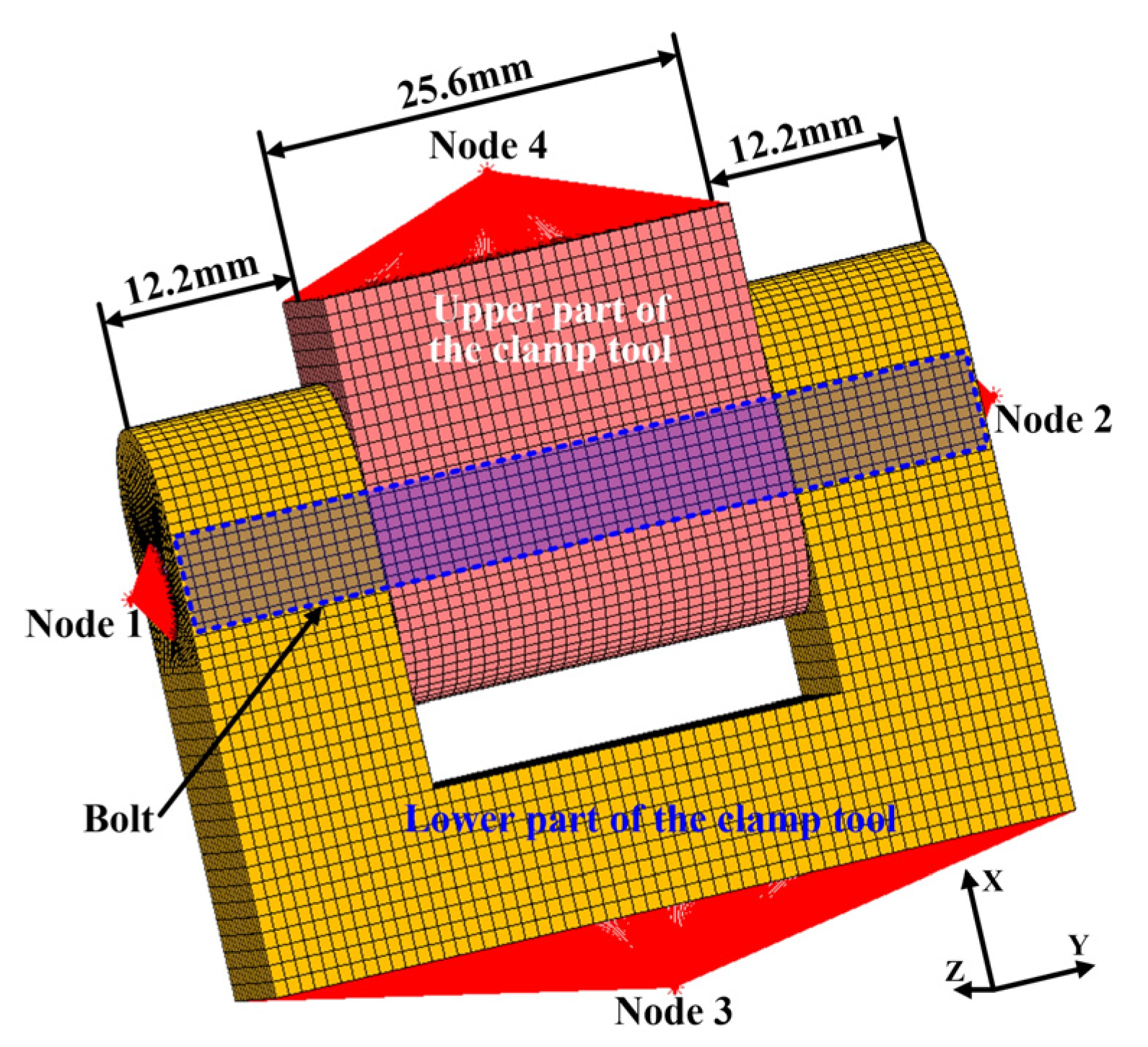



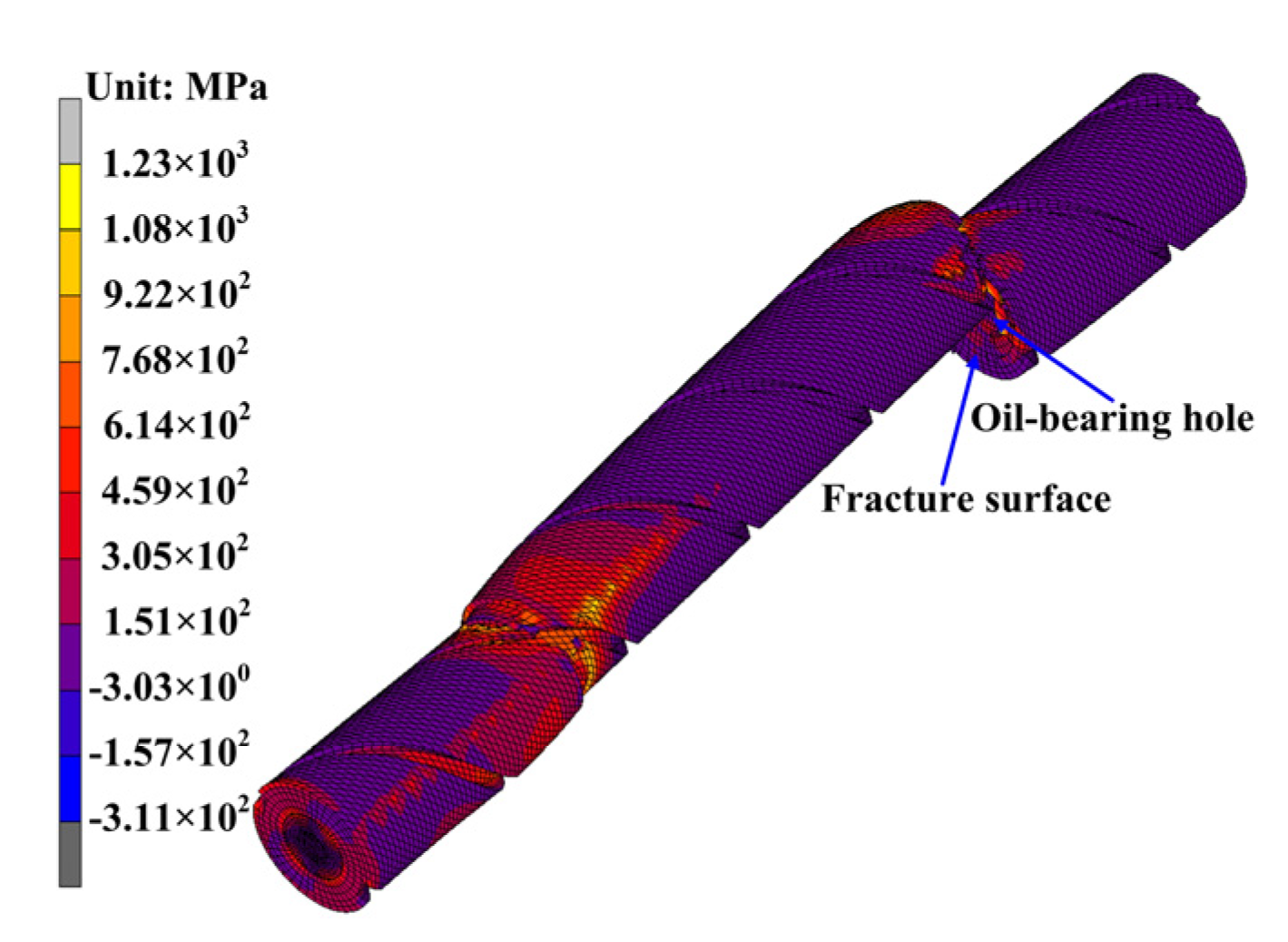

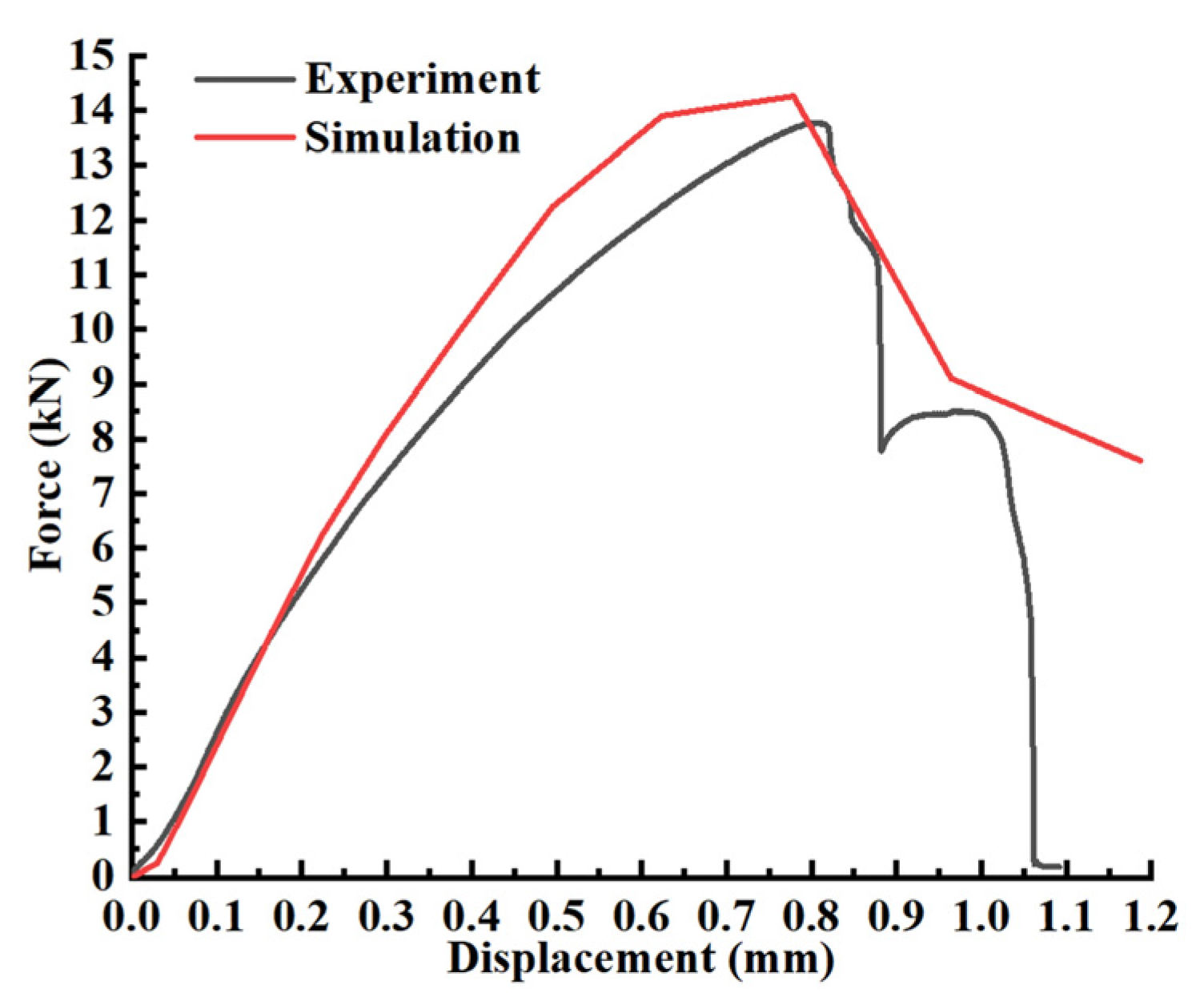

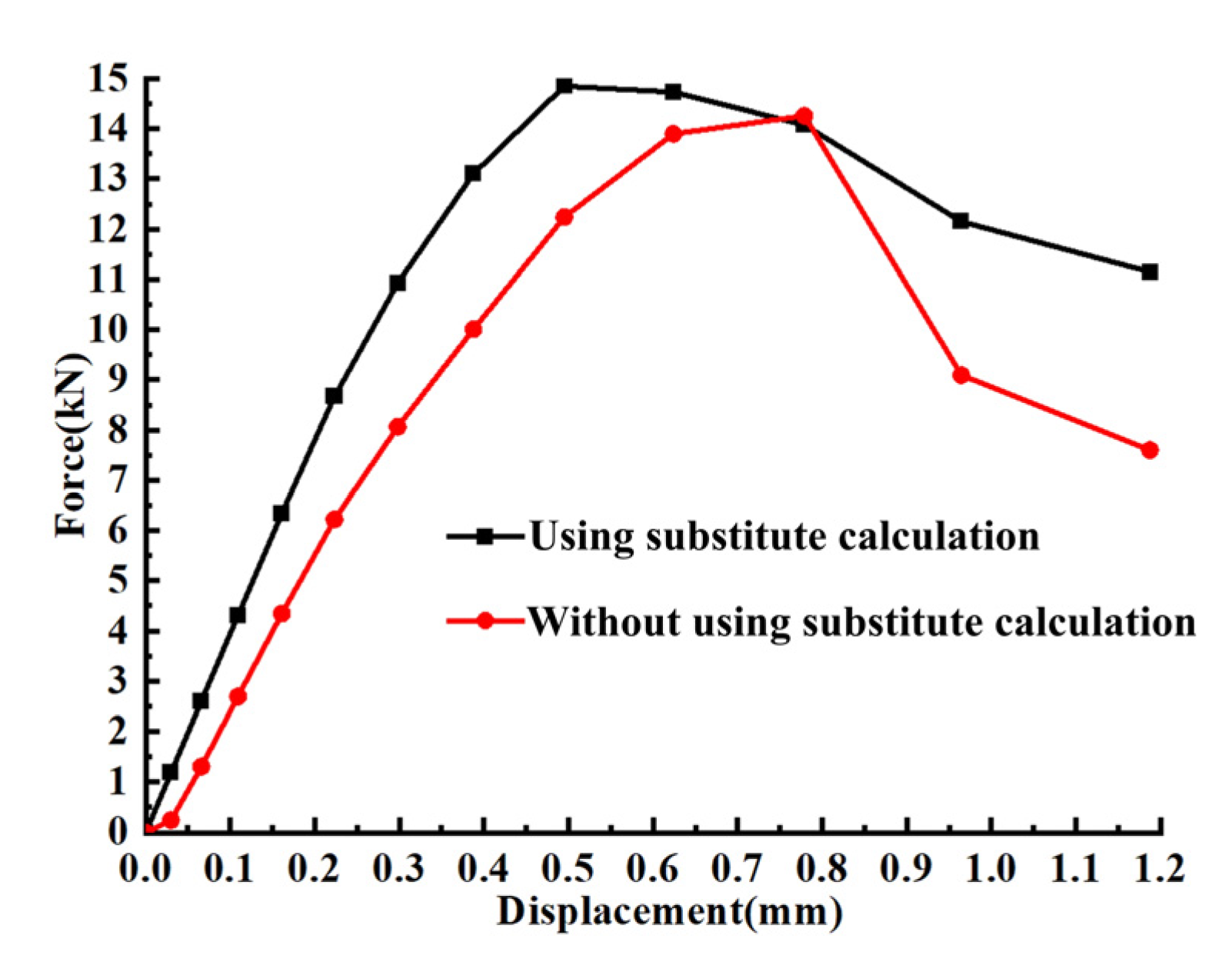
Disclaimer/Publisher’s Note: The statements, opinions and data contained in all publications are solely those of the individual author(s) and contributor(s) and not of MDPI and/or the editor(s). MDPI and/or the editor(s) disclaim responsibility for any injury to people or property resulting from any ideas, methods, instructions or products referred to in the content. |
© 2023 by the authors. Licensee MDPI, Basel, Switzerland. This article is an open access article distributed under the terms and conditions of the Creative Commons Attribution (CC BY) license (https://creativecommons.org/licenses/by/4.0/).
Share and Cite
Liu, H.; Li, C. Shear Strength Analysis of Anti-Rust Bolts with a Spiral Oil-Guiding Slot and Oil-Bearing Hole: Simulation and Experiment. Metals 2023, 13, 297. https://doi.org/10.3390/met13020297
Liu H, Li C. Shear Strength Analysis of Anti-Rust Bolts with a Spiral Oil-Guiding Slot and Oil-Bearing Hole: Simulation and Experiment. Metals. 2023; 13(2):297. https://doi.org/10.3390/met13020297
Chicago/Turabian StyleLiu, Hailang, and Chenghu Li. 2023. "Shear Strength Analysis of Anti-Rust Bolts with a Spiral Oil-Guiding Slot and Oil-Bearing Hole: Simulation and Experiment" Metals 13, no. 2: 297. https://doi.org/10.3390/met13020297





